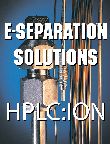Technology Forum: HPLC/ Ion Chromatography
This month, Chromatography Online's Technology Forum looks at the topic of HPLC/ Ion Chromatography and the trends and issues surrounding it. Joining us for this discussion is Chris Pohl of Dionex Corporation, Jody Clark of Selerity Technologies, Scott Anderson and Laura Kaepplinger of Grace Davison Discovery Sciences, and Doug McCabe of Waters Corporation.

The technique of HPLC continues to be the workhorse in the analytical laboratory, and even though many up-and-coming techniques are threatening to displace it, HPLC in all of its forms, including ion, remains the dominant technique in the field to this day.
This month, Chromatography Online's Technology Forum looks at the topic of HPLC/ Ion Chromatography and the trends and issues surrounding it. Joining us for this discussion is Chris Pohl of Dionex Corporation, Jody Clark of Selerity Technologies, Scott Anderson and Laura Kaepplinger of Grace Davison Discovery Sciences, and Doug McCabe of Waters Corporation.
What trends do you see emerging in HPLC and/or HPLC-ion?
Pohl: Major trends now emerging include a renewed interest in high-speed chromatography, monolithic materials designed for small ions, and the use of multi-dimensional separations. High-speed ion chromatography materials have been available for many years. For example, columns that can separate the seven common anions in about two minutes have been available since 1987, but at the time of introduction there was relatively little interest. With the prominence of ultrafast HPLC applications, there is renewed interest in high-speed IC materials. Monolithic materials are ideally suited to high-speed applications. Because of their high permeability compared to particle-based materials, use of monolithic materials at high linear velocity does not result in excessive column pressures. You can expect to see commercial ion chromatography columns within the next year based on monolithic technology. In the area of multidimensional separations, a particularly powerful trend is toward the use of multiple dimensions with the second dimension at a smaller scale than the first dimension. For example, if the first dimension uses a 4 mm column and the second dimension uses a 1 mm column, the results is a 16-fold increase in sensitivity on top of the selectivity and specificity benefits of two-dimensional separations. This approach has already been incorporated into two new U.S. EPA methods.
Clark:The trends that I see in HPLC are faster analysis times without compromising resolution or productivity. This is being achieved by using higher pressures and/or temperatures.
Anderson and Kaepplinger: A major trend we see is the need for greater productivity. Chemists need to analyze more samples, generate more data to satisfy new requirements, and/or are pressured to save money by performing tasks faster. Similarly, there's a desire to reduce complexity and streamline processes by combining or removing steps. Consequently, we expect to see HPLC products and techniques that increase analysis speed or simplify workflow.
McCabe: Like many consumer products that we see in our everyday lives, the trend that we have been seeing in chromatography during the first few years of the 21st century is miniaturization. In other words, separation media (particles), columns, and to some extent systems, are getting smaller. One of the primary drivers for this trend is that smaller particle-based columns provide more information in less time. Of course, the price that must be paid for faster, higher resolution separations is back-pressure. There are now higher pressure-capable LC systems on the market that can routinely handle the increased back-pressures encountered with higher resolution, smaller particle-based columns.
What is the future of HPLC and/or HPLC-ion?
Pohl: The future of ion chromatography appears headed toward higher levels of integration and specialization. Increasingly there is a need for instruments that can be operated with little or no user training. Future instruments will likely feature "always on, always ready" capabilities where the instrument runs continuously so that it's always available for sample analysis. With analysis times of less than 60 seconds, automatic calibration, and walk-up usability future ion analysis instrumentation will be closer to an "ion meter" than an ion chromatograph. Even though chromatography will remain at the heart of such an instrument, the user will be scarcely aware of this fact with such a high level of component integration.
Clark:I think that the future is in using high temperature in conjunction with high pressure and programming both the temperature and pressure to achieve maximum results.
Anderson and Kaepplinger:We think the future will be towards products that ultimately deliver speed and a higher confidence in sample characterization. Products that produce equivalent results in less time, or continue to improve on resolution and selectivity should drive innovation. Smaller particles, novel chemistries, robust packings, and innovative hardware will likely be the focus of new product introductions and techniques.
McCabe:As mentioned earlier the continued goal of higher resolution, improved chromatographic fidelity, and increased throughput will continue to drive HPLC innovation in the future. These fundamental improvements will drive the ongoing development of streamlined sample preparation, flexible data handling, faster and more responsive detection (including MS), and lower method limits of detection.
What is the HPLC and/or HPLC-ion application area that you see growing the fastest?
Pohl: Measurement of disinfection byproduct anions in drinking water and bottled water has been a major area of growth over the past decade. I expect this trend will continue as regulatory agencies continue to regulate additional analytes and require increasingly stringent detection limits. Other areas of significant growth are biofuels and metabolomics.
Clark:The pharmaceutical industry seems to be concentrating on proteins.
Anderson and Kaepplinger:Biotechnology and proteomic definition are of particular interest. Greater understanding of protein interactions and structure seem to now be a part of all areas of life science. Whether part of a true biotechnology application, or used to better understand drug interactions with cell function and structure, proteomics is integral to expanding the life science knowledge base. We expect these applications to continue to grow and require products that are differentiated with respect to protein and peptide separations.
McCabe:Although we are presently seeing substantial growth in several application areas, environmental analysis is presently experiencing significant growth. As we know, on a worldwide basis, there is more and more attention being placed on monitoring pollutant levels in drinking water supplies. Contaminants such as endocrine disrupting compounds and perfluorinated alkyl compounds require sensitive and selective methods such as UHPLC-MS-MS in order to quantify and confirm these target analytes at extremely low concentrations.
What obstacles stand in the way of HPLC and/or HPLC-ion development?
Pohl: Probably the biggest obstacle standing in the way of ion chromatography instrumentation development is the lack of polymeric materials with the necessary engineering properties. Currently there is still no polymeric material with structural properties suitable for high-pressure operation and simultaneously compatible with concentrated acids and bases along with common HPLC solvents. This limitation compromises equipment manufacturers' ability to make use of high-pressure, ultrahigh performance ion chromatography media.
Clark:The instrumentation for these trends is available and works very well; however, the column technology needs improvement not only with the chemistry involved in the packing material, but also the packing procedures and column housings.
Anderson and Kaepplinger:HPLC innovation is alive and well. Development of products tends to be paced slightly ahead of market acceptance of new technologies. Existing techniques and methodology that are ingrained in day-to-day functions are difficult to change, and regulatory definitions that require product or technique substitutions can be slow. Therefore getting a timely return on investment which fuels new development is limited.
McCabe:Much attention has been placed on producing shorter, higher resolution separations with more information content per unit time. These innovations have moved the bottleneck of the chromatographic laboratory away from the separation time itself to areas such as sample preparation. Cleaner samples need to be prepared faster, and in a more cost-effective manner. For example, LC-MS-MS is the primary quantitative tool DMPK for bioanalytical quantitation and bioequivalence studies. Insufficient or inadequate sample cleanup can produce MS ion suppression, short column lifetimes, and loss of sample throughput.
What was the biggest accomplishment or news during the past year for HPLC and/or HPLC-ion?
Anderson and Kaepplinger: The recent interest in alternate energy sources is spurring new business development. As a result we have seen demand for new applications and solutions which solve challenges for this emerging market.
McCabe:Although there have been many technical innovations in the field of liquid chromatography, the proliferation of








